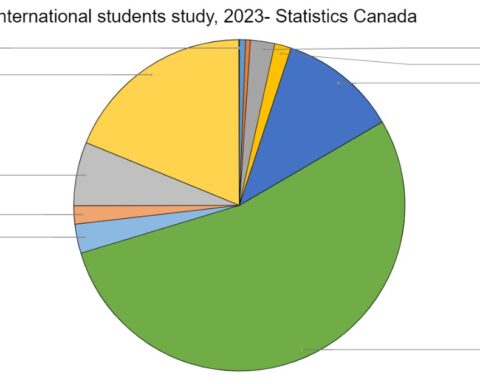Facing unprecedented lows in immigration, Canada is opening its doors wider to attract and retain skilled individuals and talent from around the world. On the eve of Valentine’s Day, the government announced that it will be sending out letters to approximately 27,300 migrant workers with Canadian experience inviting them to apply for permanent residence.
A day earlier, Ottawa announced that international students who complete their entire post-secondary program online will now be eligible for the three-year open work permit after graduation. Previously, online learning could not count towards a Post-Graduation Work Permit (PGWP) application.
The announcements come in the wake of government data released last week that showed the 2020 immigration intake was the lowest since the late 1990s. Canada added 184,370 permanent residents last year, down from 341,175 in 2019. Prime Minister Justin Trudeau’s government had targeted 341,000 newcomers in 2020.
“With travel restrictions limiting who can come to Canada, Immigration, Refugees and Citizenship Canada (IRCC) is pioneering new ways to engage those who are already here and hard at work. Their status may be temporary, but their contributions are lasting—and we’re hoping to help more of them stay permanently,” the government said in a statement.
More than 90 per cent of Canadian Experience Class (CEC) candidates who will receive invitations to apply for residency are already living in Canada.
“This means they’re unaffected by current travel restrictions and won’t face the same barriers as overseas applicants when gathering the required documentation and undergoing criminality and medical screening. Those invited to apply who are not currently living in Canada will be able to travel once restrictions are lifted,” the statement said.
Focus on international students
The pandemic has also presented myriad challenges for the international student market, which contributes more than $21 billion annually to the Canadian economy.
“Whether as health workers on the pandemic’s front lines, or as founders of some of the most promising start-ups, international students are giving back to communities across Canada as we continue the fight against the pandemic,” said Marco Mendicino, Minister of Immigration, Refugees and Citizenship.
“This new policy means that students hoping to work in Canada after graduation won’t miss out on opportunities, while ensuring that Canada meets the urgent needs of our economy for today and tomorrow. Our message to international students and graduates is simple: We don’t just want you to study here, we want you to stay here.”
More than 58,000 graduates successfully applied to immigrate permanently in 2019, according to government data.
The need for more new skills and talent is becoming more acute as the projections show that while there are currently three working Canadians for every retired Canadian, by 2035, there will be only two workers for every retiree.
In 1971, the ratio of working-age population to seniors was 6.6 to 1.
Without immigrants to help support the needs of an aging population, younger Canadians will end up paying more per person to provide the same benefits, Mendicino said.
Immigration impacts on health care
Currently Statistics Canada reports that one in three businesses with employees is owned by an immigrant, creating thousands of jobs in many different industries, from construction to retail.
The outsized role of new Canadians in the health-care and medical sectors has been particularly amplified throughout the pandemic: they account for over one third of doctors and pharmacists in the country.
More than 1.6 million people work in Canada’s health-care sector and many more will be needed in the coming years to ensure continued access to high quality care.
Almost 500,000 workers in the health-care sector are over the age of 55, and most of them will be retiring in the next decade or so. In addition, there are existing recruitment challenges from everywhere in Canada for nurses, residential care staff and home health-care staff, said IRCC.
Statistics Canada studies show that immigrants make up 37 per cent of pharmacists, 36 per cent of physicians, 39 per cent of dentists, 23 per cent of registered nurses, and 35 per cent of nurse aides and related occupations.
More than 40 per cent of newcomers to Canada between 2011 and 2016 who were working in health care were employed in the areas of nursing and residential care facilities, as well as home health-care services.
By the numbers: a glance at why immigration matters to Canada
- Science and Technology: As many as 34 per cent of people working in scientific research and development services across Canada are foreign-born. Nearly 500,000 immigrants working in Canada are trained in science, technology, engineering and mathematics (STEM) fields. Immigrants represent 24 per cent of the national workforce but account for 39 per cent of computer programmers, 41 per cent of engineers and more than 50 per cent of all chemists.
- Business: Immigrants account for 33 per cent of all business owners with paid staff, creating important local jobs in all sectors of our economy such as construction, professional services, health care and retail trade. There are more than 600,000 self-employed immigrants across the country, and over 260,000 of them have paid employees.
- Food Services: More than a quarter of workers in the food and beverage sector are immigrants. Across the country, immigrants make up more than half (53 per cent) of business owners with paid staff in the food and beverage sector. New immigrants are helping to grow the food services sector. In 2016, more than 3,200 recent immigrants across the country owned a food or beverage business.
- Arts and Culture: There are more than 80,000 immigrants working in professional and technical occupations in arts and culture across the country. One in four people employed as an artisan or craftsperson in Canada is an immigrant. Nearly 30 per cent of independent artists, writers and performers are immigrants. Across the country, there are more than 3,000 businesses in the arts and culture sector owned by immigrants.
- Sports: There are more than 2,800 immigrants working as athletes, coaches, officials and referees across the country. Immigrants make up 20 per cent of all people working in Canada as sports coaches. There are more than 16,000 immigrants who earn their living as program leaders and instructors in recreation, sport and fitness.
Data based on Statistics Canada 2016 Census.
A multiple-award winning journalist, Fabian Dawson is an internationally acclaimed author, filmmaker and media expert. His work over the last four decades spans the globe and he also serves as a consultant/strategic advisor to a variety of international companies. As deputy editor-in-chief of The Province, part of the Postmedia chain, Dawson led initiatives within a special publications group to provide directed content for a variety of organisations. He was named the 2019 recipient of the Bruce Hutchison Lifetime Achievement Award at Jack Webster Awards. Dawson has been invited by the governments of India, Malaysia, Taiwan, China, Hong Kong and the United States to act as a media observer/advisor on a variety of Asian-Canada issues. Dawson, now operates FD Media, which specializes in harnessing editorial assets to revenue generating opportunities.





